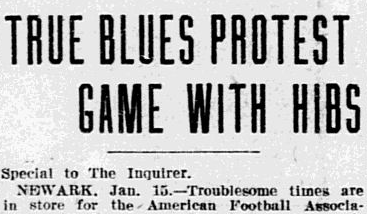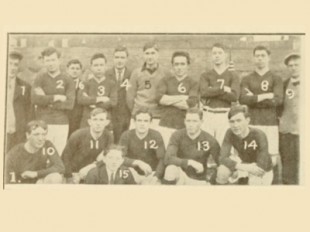Photo: Philadelphia Hibernian, 1914
Our series on soccer in Philadelphia one hundred years ago continues.
Local teams battle in American Cup quarterfinals
Four of the eight teams in the third round of the 1913-14 American Cup played in Philadelphia leagues. Pennsylvania Leaguers Victor had already played to one third round draw and fellow professionals Hibernian was scheduled to face Paterson True Blues on Jan. 10. Reigning champions of the amateur Allied American League first division, Bethlehem FC, had also already played to a third round draw. Pennsylvania Leaguers Tacony would not meet Brooklyn FC in third round play until Jan. 17, 1914.
As had so often been — and would continue to be — the case, poor winter weather had an adverse affect on play when Victor and Bethlehem hosted their third round opponents on Dec. 27, 1913, with high winds and icy fields taking their toll. In the end, Victor and Jersey AC played to a 1-1 draw at Front and Erie, while Bethlehem and West Hudson finished with the same scoreline in Bethlehem.
The Steelworkers had already left Bethlehem for their replay against the West Hudsons in Harrison, New Jersey on a stormy Jan. 3, 1914 by the time a telegram arrived telling them to stay at home. They reached Harrison in what the Inquirer described on Jan. 4 as “a storm of sleet, wind, and rain” to find the Harrison Oval “heavy with mud and water.” To the surprise of everyone, the referee ordered the game played. Then, with the scoreline tied at 1-1 late in the second half, the referee finally suspended the game.
Victor and Bethlehem would both be on the road for their replays, each playing what was for Pennsylvania teams an rare all-too-rare Sunday game on Jan. 11, 1914.
Hibs top reigning American Cup champions to advance to the semifinals
Given how much the weather had affected the Victor and Bethlehem games, Hibernian was fortunate that their third round meeting with reigning American Cup champions the Paterson True Blues wasn’t scheduled until Jan. 10, 1914. Playing at Potter’s Field at Front and Erie, Hibs opened the scoring when inside left Scott finished a delivery from a corner kick. The game soon “became rough, frequent fouls being called.” Just before the half, the True Blues equalized.
But Hibernian was finding success attacking down the visitor’s right and in the second half outside left Hunt would score game winner. Describing the “magnificent goal,” the Inquirer match report on Jan. 11 said, “Hunt received the ball close to his own 18-yard mark and with a fine bit of dribbling, the like of which has seldom been witnessed this season, beat man after man, finishing up with a splendid shot that was labelled all the way.” The Inquirer related, “The players clapped him and the crowd cheered him.”
The Inquirer report concluded simply, “It was a case of the better team winning.”
 The True Blues felt otherwise and on Jan. 15 the team filed a protest with the American Football Association, organizers of the tournament, claiming that Scott’s goal should not have been allowed. The Inquirer reported on Jan. 15, ‘The Blues are past masters of the art of registering protests,” noting that an earlier protest against the Fall River Rovers for fielding an ineligible had resulted in an order to replay their second round match, which had been won by the Rovers, 2-0. Unhappy with the decision, Fall River refused to play and had forfeited the game.
The True Blues felt otherwise and on Jan. 15 the team filed a protest with the American Football Association, organizers of the tournament, claiming that Scott’s goal should not have been allowed. The Inquirer reported on Jan. 15, ‘The Blues are past masters of the art of registering protests,” noting that an earlier protest against the Fall River Rovers for fielding an ineligible had resulted in an order to replay their second round match, which had been won by the Rovers, 2-0. Unhappy with the decision, Fall River refused to play and had forfeited the game.
Victor draw again with Jersey City
The day after the Hibs win, Victor and Jersey City battled though 90 minutes of regulation time and two extra 15 minute periods before concluding with a 0-0 draw. There had been good opportunities for both teams to win. Three minutes into the first extra time period, Jersey City center forward Newman was free on a breakaway with only the Victor keeper to beat when, “only about five yards from goal,” he “fell over ignominiously, this being about the closest shave that the homesters had of winning the match.”
During the second half of regulation play, Victor scored directly from a corner kick, “the wind carrying [the ball] just over the line without a second player touching it.” Correctly following the rules of the day, the referee disallowed the goal and whistled for a six-yard kick. It was a situation that echoed the cause of the True Blues protest against Hibernian only in that case the referee had judged that the ball had not crossed the goal line before Scott finished it.
While acknowledging that the Victor forwards didn’t have the best of days, and that one Victor player proved to be a non-factor after receiving a kick to the knee in the first half, the Inquirer reported, “It was a case of Jack being as good as his master, though the credit belongs to the Quaker aggregation for the manner that they held their sturdier opponents in check.”
Bethlehem and West Hudson finish level for third time
Unlike their first two meetings, when Bethlehem and West Hudson met on Jan. 11 in Newark, the weather conditions were ideal. Some 2,500 spectators were on hand for the contest, including a party of 150 Bethlehem supporters who had traveled by a special three-coach train to the game. The South Bethlehem Globe reported on Jan. 12, “All the rooters wore the Bethlehem colors, Blue and White, and on their arrival in Newark special trolley cars were in waiting to convey them to the grounds.”
Bethlehem were first to tally when outside left, and future National Soccer Hall of Famer, Tommy Fleming scored with a low drive into the corner of the net. However, the lead was short-lived and the teams entered the half tied at 1-1.
The Inquirer reported on Jan. 12 that the two teams then “battled fiercely” through a scoreless second half and two extra time periods. Fleming actually hit the back of the net a second time in the first period of extra time, but the goal was disallowed. The Globe reported, “the Bethlehems team worked the ball down the field beautifully…the crowd gave vent to its feeling, cheering and shouting, but this suddenly stopped when the referee refused to allow the goal, claiming that Fleming was offsides.”
As was the case with Victor and Jersey City, another game would have to be played before it would be known which team would advance to the tournament semifinals. Whether Hibernian would have to replay the True Blue was still to be decided.
League play
A handful of league games took place back in Philadelphia on Jan. 10, 1914. In the Allied League first division, Peabody and Smith AA met in a replay of the game that had been abandoned in the previous week’s inclement weather. That game had ended with Peabody winning 2-1 before the match was called ten minutes before full time. In the replay at Washington Park, located at 26th and Allegheny, Peabody was the 1-0 winner. In the other first division game of the day, Disston easily defeated Kensington 4-0 at Tacony Park.
In second division play, Putnam brushed aside Fairhill Wanderers, 4-1, at 22nd and Huntingdon streets. At Front and Allegheny, Manchester Unity defeated Marcus Hook, 2-0. In third division play, Chester’s Linwood Hibernians defeated Wilmington’s Windsors, 3-0.
Four American League games were played on Jan. 10. League-leaders Philadelphia Electrics defeated Victor AA 2-1 at Frankford and Berks. Kensington Boys’ Club kept their second place standing with a 3-0 win over Rangers at Boys’ Club Farm. Frankford traveled to Clifton to face Victoria Plush Mill and returned home 3-1 losers, Victoria center forward Radley netting a brace. Down 1-0 at the half against the visiting Whitehall Rovers, Cardington roared back in the second half to win 3-1.
A full slate of United League games was played with six games on the day. Five of the games were blowouts, the winners tallying 21 goals to the losers’ four; none of the winners scored fewer than four goals. The match between West End AC and Christ Church at 62nd and South proved to be uncharacteristically tight and finished in a 1-1 draw.
Cricket Club League leaders Merchantville had been scheduled to play Brooklyn’s Crescent Athletic Club on Dec. 27, 1913 to determine the winner of the Crescent Cup, the annual contest between the reigning champions of the Associated Cricket Club League of Philadelphia and the Field Club League of New York. Both teams were shorthanded on the day and agreed to play an exhibition game instead. While both teams were at full strength when they met for their rescheduled Cup tie on Jan. 10, Crescent AC proved to be easy 3-0 victors. The Inquirer reported on Jan. 11, “There was no doubting the superiority of the Crescents, as they outgeneraled and outplayed their opponents all the way through.”


Comments